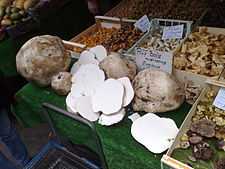Calvatia gigantea
| Giant puffball | |
|---|---|
| | |
| Giant Puffball mushroom in local park, Darien CT October 2014. Hand shown for scale. | |
| Scientific classification | |
| Kingdom: | Fungi |
| Phylum: | Basidiomycota |
| Class: | Agaricomycetes |
| Order: | Agaricales |
| Family: | Lycoperdaceae |
| Genus: | Calvatia |
| Species: | C. gigantea |
| Binomial name | |
| Calvatia gigantea (Batsch ex Pers.) Lloyd | |
| Calvatia gigantea | |
|---|---|
|
| |
| glebal hymenium | |
| no distinct cap | |
| hymenium attachment is not applicable | |
| lacks a stipe | |
| spore print is brown | |
| ecology is mycorrhizal | |
| edibility: edible | |
Calvatia gigantea, commonly known as the Giant puffball, is a puffball mushroom commonly found in meadows, fields, and deciduous forests worldwide usually in late summer and autumn. It is common throughout Europe and North America.
Description
Most giant puffballs grow to be 10 to 70 centimetres (3.9 to 27.6 in) in diameter, although occasionally some can reach diameters up to 150 centimetres (59 in) and weights of 20 kilograms (44 lb). The inside of mature Giant puffballs is greenish brown, whereas the interior of immature puffballs is white. The large white mushrooms are edible when young.[1][2]
The fruiting body of a puffball mushroom will develop within the period of a few weeks and soon begin to decompose and rot, at which point it is dangerous to eat. Unlike most mushrooms, all the spores of the giant puffball are created inside the fruiting body; large specimens can easily contain several trillion spores. Spores are yellowish, smooth, and 3 to 5 micrometres (0.00012 to 0.00020 in) in size.[1][2]
The classification of this species has been revised in recent years, as the formerly recognized class Gasteromycetes, which included all puffballs, has been found to be polyphyletic. Some authors place the giant puffball and other members of genus Calvatia in order Agaricales. Also, the species has in the past been placed in two other genera, Lycoperdon and Langermannia. However, the current view is that the Giant Puffball is Calvatia.[3]
Conservation status
"Widespread and fairly common, and not considered of conservation concern in the UK. However, it is protected in parts of Poland and considered rare in Lithuania and of conservation concern in Norway."
Cooking

All true puffballs are considered edible when immature, but can cause digestive upset if the spores have begun to form, as indicated by the color of the flesh being not pure white (first yellow, then brown). Immature gilled species still contained within their universal veil can be look alikes for puffballs. To distinguish puffballs from poisonous fungi, they must be cut open; edible puffballs will have a solid white interior. Some similar mushrooms have the white interior (or yellowish) but also have the silhouette of a cap-type mushroom on the interior when cut open. These are young cap-type mushrooms and may be poisonous.
The meat of giant puffballs tastes very similar to tofu or melted cheese when cooked. To prepare, remove any brown portions and tough skin, which sometimes peels off easily. Do not soak in anything. Puffballs may be sauteed, broiled, or breaded and fried; they do not dehydrate well, but may be cooked and then frozen.
Resembles
Giant puffballs resemble the earthball (Scleroderma citrinum). The latter are distinguished by a much firmer, elastic fruiting body, and as an interior that becomes dark purplish-black with white reticulation early in development.
Images
-

Giant puffball
-

Puffball mushrooms on sale at a market in England. (Note the slices are uniform and white all the way through.)
-

A giant puffball gone to spore.
-

Cut, with a fork for scale
References
- ↑ 1.0 1.1 Arora, David (1986). Mushrooms Demystified. Berkeley, California: Ten Speed Press. ISBN 0-89815-169-4.
- ↑ 2.0 2.1 Bessette, Alan E. (1997). Mushrooms of Northeastern North America. Syracuse, NY: Syracuse University Press. ISBN 0-8156-0388-6.
- ↑ Volk, First. "Tom Volk's Fungus of the Month for August 1998". Retrieved 6 October 2012.
Further Reading
Zhu, Wenyou; Guo, Chunxia; Luo, Fan (January 2015). "Optimization of Calvatia gigantea myceliaproduction from distillery wastewater". Journal of the Institute of Brewing 121 (1): 78–86. doi:10.1002/jib.200.
Kivrak, Ibrahim; Kivrak, Seyda; Harmandar, Mansur (1 September 2014). "Free amino acid profiling in the giant puffball mushroom (Calvatia gigantea) using UPLC-MS/MS". Food Chemistry 158: 88–92. doi:10.1016/j.foodchem.2014.02.108.
Coetzee, Johannes C.; Van Wyk, Abraham E. (January 2013). "Nomenclatural and taxonomic notes on Calvatia (Lycoperdaceae) and associated genera". Mycotaxon 121 (1): 29-36. doi:10.5248/121.29.
External links
| Wikimedia Commons has media related to Langermannia gigantea. |